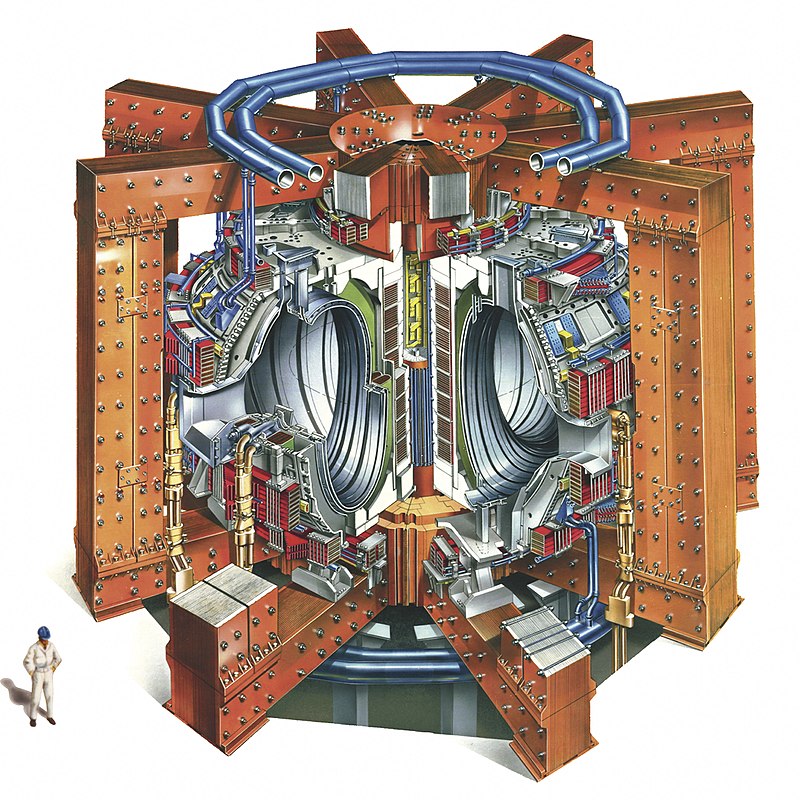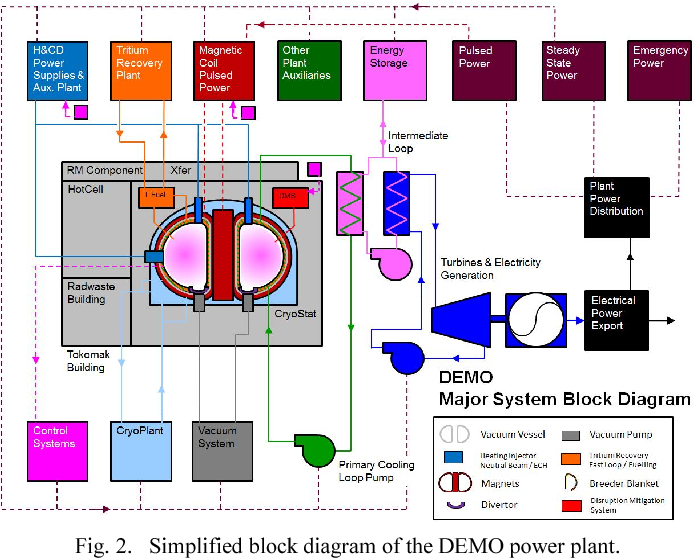What is nuclear fusion and how might a fusion powerplant work?
July 12, 2022
There are currently more than 23 commercial fusion companies trying to develop nuclear fusion, some of which have huge budgets (for example, CFS fusion which has raised 1.8 billion dollars in its series B funding). In this blog post I take a closer look at the ‘holy grail’ of clean energy. I have mostly gained my information from the UK STEP project, which aims to have a concept design by 2024 and a 100MWe prototype system by 2040.
First of all, what is fusion? Fusion is the combination of two lighter atoms into a heavier atom. Some oversimplified physics: Within a nucleus (the central bit that has most of the mass of an atom) there are two main forces, electromagnetism and the strong force. The electromagnetic force causes nuclei to repel each other, since protons are all positively charged, while the strong force is what pulls them together, stopping the nuclei of all elements from flying apart (since all protons are positively charged). In order for the strong force to dominate and hold the nucleus together, the nucleons must be brought very close together, otherwise, the repulsive electromagnetic force dominates. To get these atoms close enough together so that the strong force can overcome the electromagnetic force requires the nuclei to have enormous kinetic energy, and hence requires temperatures of order 150 million Celcius$^{1}$.
$^{1}$While fusion can happen in the sun at temperatures 10 times lower than this, the lack of the sun's gravitational pull here on earth means we need much higher temperatures!
How do we make something that hot? Well as it turns out this is difficult and requires a lot of power. The ITER European fusion project will use several heating methods: First, Ohmic resistance heating, driven by the changing magnetic fields which in turn drive a high intensity current through the plasma. Second, neutral beam injection which fires highly energetic neutrally charged particles into the plasma which then collide with the plasma particles, increasing their kinetic energy. Interestingly, these are produced by accelerating charged particles and then passing them through a neutraliser where the electrical charge is removed before injection. Thirdly, high frequency magnetic waves carry energy into the plasma which is then transferred to the charged particles (much like a microwave heats food). If the plasma is made hot enough then the fusion reaction may be made self-sustaining for a period of time - i.e. a burning plasma - where the reaction heat is enough to sustain the temperature. The reaction that fusion hopes to achieve is as follows: \begin{equation} { }^1_1H \mbox{ (Deuterium)} + { }^3_1H \mbox{ (Tritium)} \rightarrow { }^4_2He \mbox{ (Helium)} + n \mbox{ (free neutron)} \end{equation}
In this reaction, 17.6 MeV ($= 2.8184 \times 10^{-12}$ Joules) of energy is released due to the net decrease in the mass of the products as compared to the reactants. Of this, 14.1 MeV is with the neutron and 3.5 with the Helium. These numbers explain why the reaction is so attractive. Converted into energy per mass of fuel, we find that 1kg of a Deuterium/Tritium mix could yield $\frac{\mbox{mass Deuterium fuel}}{\mbox{mass Deuterium atom}} = \frac{0.4}{2\times1.6727\times10^{-27}}=1.2\times10^{26}$ reactions. Thus it would release $3.4\times10^{14}$ J or $96$ GWh of energy. This is obviously a huge number and this amount of energy from a non-fossil fuel resource would be hugely beneficial in our search for clean energy.

Figure 1: Taken from here . The Figure shows the JET tokamak design. The plasma is contained by huge magnetic fields in the torus. The kinetic energy achieved by the particles in the torus during experimental burns makes it the hottest place in the solar system!
So this all sounds great, but how might the system work in practice? In a typical thermal power system we just use the hot exhaust gases to heat water and generate steam or directly heat air which drives either a steam turbine or an engine (this could be a gas turbine). As it turns out getting heat out of the plasma at 130 million Celcius is not straightforward. This is because the reaction has to be contained otherwise the temperature will drop and the reaction stops, and furthermore there is all of the heating that is required to get the plasma to temperature and contain it, and this consumes a huge amount of power. This includes all the energy for the ohmic, beam injection and magnetic heating but also pumping power for maintaining the vacuum in the reaction chamber and the power to cryogenically cool the superconducting magnets down to 20K which are responsible for the containment. For example, in the JET fusion reactor, the system draws 600 MW of power from the UK grid (which can be 2-3% of the total grid load!), which must be supplemented from the power stored in two large flywheel systems in order to run an experimental burn. This huge amount of power drawn means that the tests can only be run when the demand on the electrical system is low!
There have been a number of solutions proposed so far on how to actually extract power from a fusion reactor, however arguably the most plausible involves allowing the neutron to escape the plasma and capturing it in a Lithium Breeder blanket. This heats the blanket as the neutron interacts with the Lithium in the blanket to produce Tritium and Helium. The Tritium can then be re-used in the reactor, which is very useful since tritium is not a natural material and at the moment typically comes as a byproduct from nuclear fission powerplants. This ‘tritium breeding blanket’ surrounds the reaction chamber (apart from some small areas which will need to allow for fuel injection, heating equipment and pump access), and this is where the heat is extracted (some heat may also be extracted from the plasma exhaust). The high energy neutrons interact with the breeder blanket - producing tritium for the reactor - and this increases the breeder blanket temperature. Depending on the exact materials used (there are a number of different options for tritium breeding), different temperatures may be tolerated but generally the breeder blanket temperatures are in the range 500-1000C. It is this that is then the hot source used to drive a thermal engine. Most designs suggest the use of a Rankine steam cycle, so the breeder blanket is used to create superheated steam. It does this by circulating a coolant through the breeder blanket - often gaseous Helium which is also evolved in the blanket reactions. The heat is then transferred from the coolant to a molten salt system - much like those used in Concentrated Solar Power (CSP). The reason for this is to add storage to the system, since the tokamak is intrinsically better suited to providing energy in pulses. The other reason is that the salts can also be used directly as the coolant and absorber material in the breeder blanket. The salts then transfer the heat to the steam in the evaporator of the Rankine steam cycle.

Taken from The European DEMO fusion reactor: Design status and challenges from balance of plant point of view. The primary coolant loop is likely to be Pressurised high temperature Helium gas, which will exchange heat with an energy storage system that could be molten salt. This will in turn be used to create superheated steam for a rankine cycle.
So far I’ve implicitly mentioned the challenges - but it’s fair to say that there are many. And in this scratching of the surface we have not mentioned any of the control, containment and material challenges (the high energy neutrons are damaging to materials) that also need to be solved. Including the challenges associated with the plasma physics (the current generation of fusion experiments are currently working on the fundamental plasmas physics to create a burning plasma from which heat can be extracted), a working fusion reactor would surely be the most complicated piece of engineering ever built!
Further information
The UK STEP reactor concept
The EU ITER project
The JET experiment
Basics of fusion physics
The European DEMO fusion reactor: Design status and challenges from balance of plant point of view